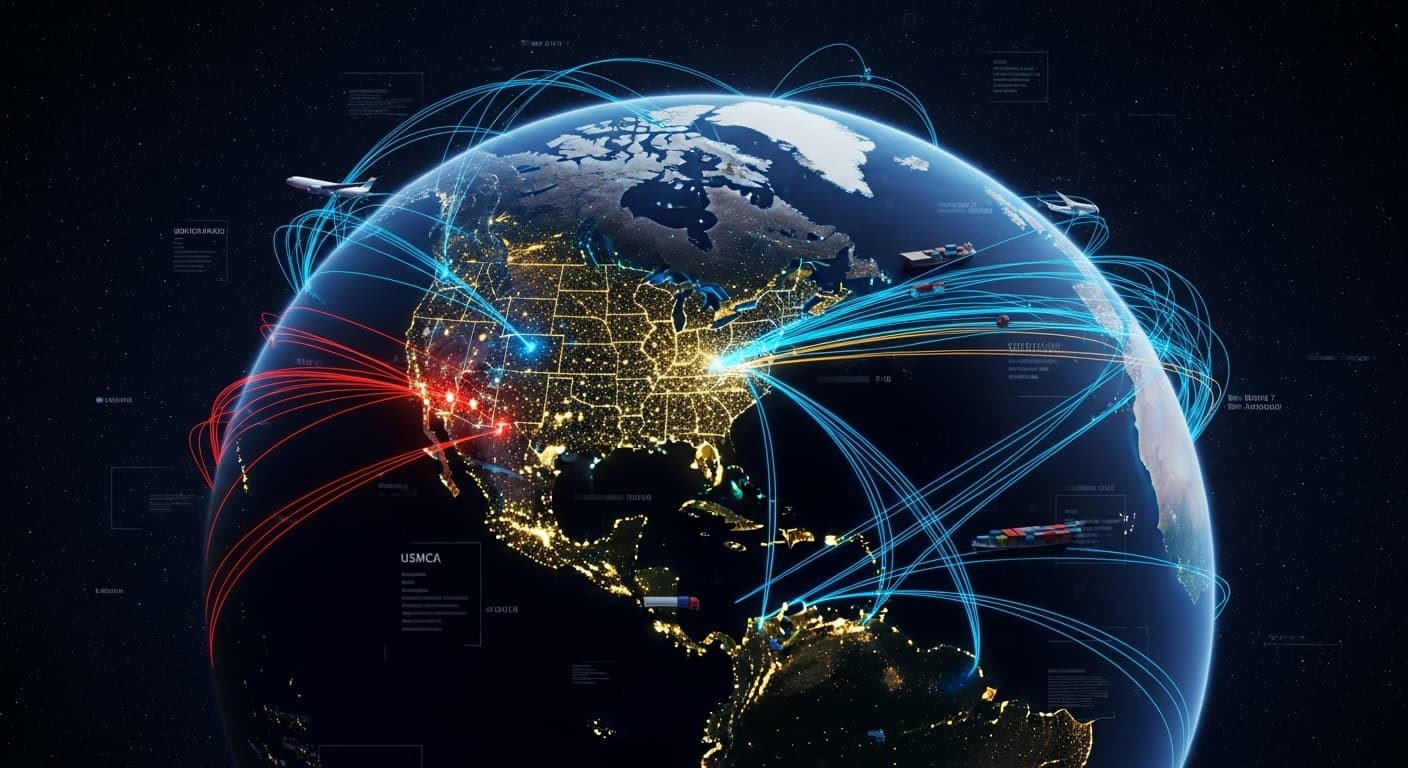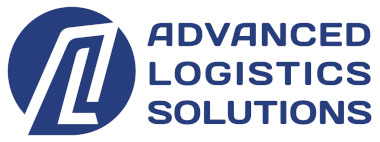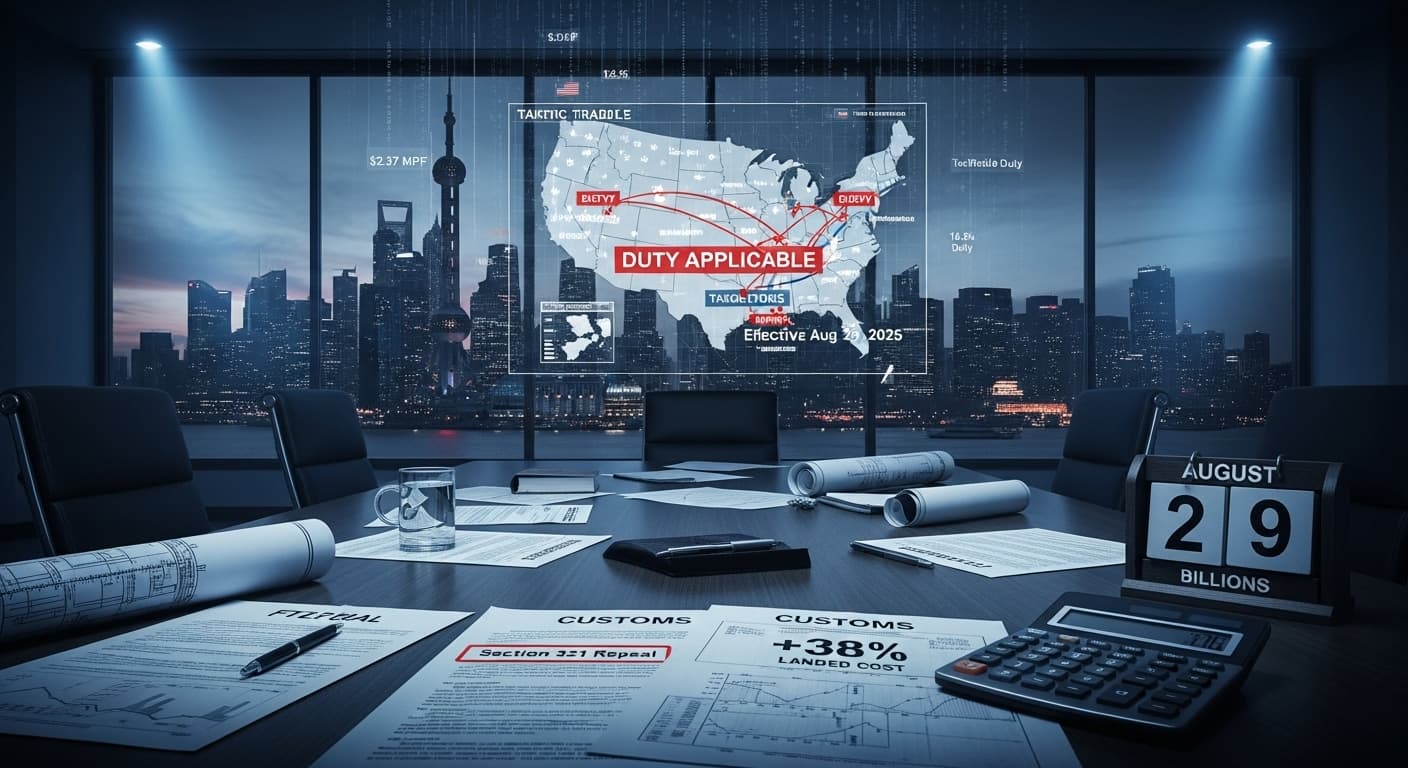
Executive Summary
The August 2025 tariff announcements mark a pivotal moment for the logistics industry. With import volumes projected to decline by over 20% and compliance requirements intensifying, logistics providers must adapt quickly to serve clients effectively in this new environment. Understanding these changes and developing strategic responses will determine competitive positioning in the months ahead.
Strategic Adaptation in the New Tariff Environment: A Comprehensive Guide for Logistics Professionals
(新关税环境下的物流战略适应:应对贸易政策变化的综合指南)
The logistics industry stands at a critical juncture. Recent tariff measures announced on August 7, 2025—imposing 15% duties on imports from Japan, South Korea, and the European Union, alongside 25% tariffs on Indian goods—represent more than policy adjustments. They signal a fundamental shift in how international trade flows will operate, creating both challenges and opportunities for logistics providers across the supply chain spectrum.
Understanding the Immediate Market Response
Volume Impact and Revenue Implications
The National Retail Federation’s projections paint a stark picture of the immediate future. Import container volumes are expected to plummet by 21.1% by November 2025, dropping from current levels of 2.3 million TEU to approximately 1.71 million TEU. This dramatic shift reflects more than statistical forecasting—it represents real changes in how businesses approach international sourcing and inventory management.
The pre-tariff surge we witnessed in July, with volumes reaching 2.3 million TEU (a 17.3% month-over-month increase), demonstrates the market’s anticipation of these changes. Companies rushed to stock inventory ahead of implementation, creating temporary volume spikes that masked underlying structural shifts in trade patterns.
Key Volume Indicators:
- July 2025: 2.3 million TEU (surge before tariff implementation)
- September 2025 (projected): 1.83 million TEU (19.5% decline)
- November 2025 (projected): 1.71 million TEU (21.1% decline)
- Revenue Impact: $28 billion in tariff collections versus $291 billion federal deficit
Regional Disruptions and Operational Challenges
The situation at Mexico’s Port of Manzanillo illustrates the complexity of modern trade enforcement. Over 900 containers of Chinese-origin goods remain abandoned due to enhanced intellectual property enforcement measures. This scenario highlights the evolving compliance landscape that logistics providers must navigate—where traditional customs clearance processes intersect with increasingly sophisticated enforcement mechanisms.
These disruptions extend beyond simple delays. They represent fundamental changes in documentation requirements, verification processes, and risk management protocols that affect every aspect of logistics operations from initial shipment booking through final delivery.
Industry Transformation Drivers
The Shift from Volume to Value-Added Services
As traditional volume-based revenue streams face pressure, successful logistics providers are pivoting toward higher-value services that help clients navigate regulatory complexity. This transformation mirrors broader industry trends toward specialization and expertise-driven business models.
Emerging Service Categories:
- Customs Compliance Consulting: Helping clients optimize classification and valuation strategies
- Trade Documentation Management: Ensuring accuracy and completeness of required paperwork
- Risk Assessment and Mitigation: Identifying potential compliance issues before they become problems
- Supply Chain Redesign: Supporting clients in restructuring sourcing and distribution networks
Technology Integration and Operational Excellence
Forward-thinking logistics providers are leveraging technology to maintain competitive advantages during periods of volume volatility. Advanced warehouse management systems (WMS) and artificial intelligence applications enable more efficient operations even as traditional volume metrics decline.
Case Example: Operational Excellence in Action Kamisumi’s U.S. subsidiary exemplifies strategic positioning through operational excellence. By establishing warehouse operations near the Port of Long Beach, the company reduced tariff exposure while enhancing service capabilities for clients. This approach demonstrates how logistics providers can create value through strategic positioning rather than relying solely on volume growth.
The integration of sustainable practices, as demonstrated by FedEx’s commitment to over 3 million gallons of sustainable aviation fuel annually, shows how industry leaders are building competitive advantages through operational innovation and environmental responsibility.
Strategic Response Framework for Logistics Providers
Supply Chain Reconfiguration Support
The most significant opportunity for logistics providers lies in helping clients adapt their supply chain structures to new trade realities. This involves more than traditional freight forwarding—it requires deep understanding of trade regulations, alternative sourcing strategies, and cost optimization approaches.
Regional Diversification Strategies:
- Nearshoring Facilitation: Supporting clients in establishing operations in Mexico, Canada, and Central America
- Alternative Sourcing: Identifying and qualifying suppliers in countries with favorable trade status
- Inventory Optimization: Helping clients balance carrying costs with tariff avoidance strategies
- Market Entry Support: Facilitating expansion into new geographic markets to offset trade restrictions
Data-Driven Decision Making
Modern logistics operations generate vast amounts of data that can provide competitive advantages when properly analyzed and applied. Advanced analytics enable better demand forecasting, route optimization, and resource allocation—capabilities that become even more valuable during periods of market uncertainty.
Analytics Applications:
- Demand Forecasting: Predicting volume fluctuations based on trade policy changes
- Cost Optimization: Identifying the most efficient routing and mode combinations
- Compliance Monitoring: Tracking regulatory changes and their operational implications
- Performance Management: Measuring service quality and client satisfaction across changing conditions
Risk Management and Contingency Planning
The current environment demands sophisticated risk management approaches that go beyond traditional cargo insurance and basic contingency planning. Logistics providers must develop comprehensive frameworks for managing regulatory risk, volume volatility, and supply chain disruptions.
Risk Mitigation Strategies:
- Diversified Service Portfolios: Reducing dependence on any single trade lane or service category
- Flexible Capacity Management: Maintaining ability to scale operations up or down based on demand
- Regulatory Expertise: Developing deep knowledge of customs regulations and compliance requirements
- Client Education: Helping clients understand and prepare for changing trade conditions
Compliance and Documentation Excellence
Enhanced Customs Procedures
The new tariff environment brings intensified scrutiny of customs documentation and compliance procedures. Logistics providers who excel in these areas can differentiate themselves significantly from competitors who treat customs clearance as a commodity service.
Critical Compliance Areas:
- Classification Accuracy: Ensuring proper Harmonized Tariff Schedule classification for all goods
- Valuation Compliance: Maintaining accurate customs valuations that withstand examination
- Origin Documentation: Providing comprehensive support for country-of-origin determinations
- Record Keeping: Maintaining detailed documentation to support client audit requirements
Proactive Communication Strategies
Successful navigation of the current environment requires proactive communication with clients about changing requirements, potential impacts, and available alternatives. This consultative approach builds stronger client relationships while positioning logistics providers as strategic partners rather than service vendors.
Communication Best Practices:
- Regular Updates: Providing timely information about regulatory changes and their implications
- Impact Analysis: Helping clients understand how changes affect their specific operations
- Alternative Solutions: Presenting options for managing increased costs or compliance requirements
- Performance Reporting: Demonstrating value through detailed performance metrics and analysis
Technology and Innovation Opportunities
Automation and Efficiency Enhancement
As labor costs continue to rise and volume patterns become less predictable, automation technologies offer opportunities for maintaining profitability while improving service quality. These investments become particularly valuable when traditional revenue models face pressure from changing trade patterns.
Automation Applications:
- Warehouse Operations: Automated sorting, picking, and packing systems that improve accuracy and efficiency
- Documentation Processing: Digital systems that streamline customs documentation and reduce processing time
- Track and Trace: Real-time visibility systems that improve customer service and operational control
- Predictive Analytics: Systems that anticipate problems and optimize resource allocation
Digital Platform Integration
The complexity of modern logistics operations requires sophisticated information systems that can integrate with client systems, carrier networks, and regulatory databases. Investment in these capabilities enables logistics providers to offer higher-value services while improving operational efficiency.
Integration Capabilities:
- Client System Connectivity: Seamless integration with client ERP and procurement systems
- Carrier Network Access: Direct connectivity with multiple transportation providers
- Regulatory Database Integration: Real-time access to customs and regulatory information
- Supply Chain Visibility: End-to-end tracking and monitoring capabilities
Market Positioning and Competitive Strategy
Specialization and Expertise Development
The current environment favors logistics providers who can demonstrate deep expertise in specific areas rather than those who compete solely on price or basic service availability. Developing recognized expertise in customs compliance, specific industry sectors, or geographic regions can provide sustainable competitive advantages.
Specialization Opportunities:
- Industry Expertise: Developing deep knowledge of specific industry requirements and challenges
- Geographic Focus: Building specialized capabilities for specific trade lanes or regions
- Regulatory Expertise: Becoming recognized experts in customs compliance and trade regulations
- Technology Integration: Offering advanced technology solutions that competitors cannot match
Client Relationship Evolution
The shift toward more complex trade requirements creates opportunities for deeper client relationships based on strategic partnership rather than transactional service provision. These relationships provide more stable revenue streams and better growth opportunities than traditional volume-based business models.
Relationship Building Strategies:
- Strategic Planning Support: Helping clients develop long-term supply chain strategies
- Regular Business Reviews: Conducting periodic assessments of performance and opportunities
- Industry Intelligence: Providing valuable market insights and trend analysis
- Problem-Solving Partnership: Working collaboratively to address challenges and optimize operations
Regional Market Dynamics
North American Trade Corridor Opportunities
The emphasis on nearshoring and regional trade relationships creates significant opportunities for logistics providers who can effectively serve North American trade corridors. The USMCA agreement provides a framework for enhanced regional integration that logistics companies can leverage for competitive advantage.
Regional Strategy Elements:
- Cross-Border Expertise: Developing specialized capabilities for U.S.-Mexico and U.S.-Canada trade
- Regulatory Knowledge: Understanding USMCA rules of origin and compliance requirements
- Infrastructure Investment: Strategic positioning of facilities to serve regional trade flows
- Cultural Competency: Building teams that understand regional business practices and requirements
Asian Market Adaptation
While tariffs create challenges for traditional Asian trade routes, opportunities remain for logistics providers who can help clients navigate the new environment effectively. This requires sophisticated understanding of alternative routing options, compliance strategies, and cost optimization approaches.
Asian Market Strategies:
- Alternative Routing: Identifying cost-effective routing options through different countries or regions
- Compliance Support: Providing expertise in navigating complex tariff and regulatory requirements
- Inventory Management: Helping clients optimize inventory positioning to minimize tariff impact
- Supplier Development: Supporting clients in diversifying supplier bases across multiple countries
Financial Management and Pricing Strategies
Cost Structure Adaptation
The new tariff environment requires careful analysis of cost structures and pricing models to maintain profitability while remaining competitive. This involves understanding not just direct tariff impacts but also secondary effects on transportation costs, handling requirements, and compliance expenses.
Cost Management Approaches:
- Activity-Based Costing: Understanding true costs of different services and client requirements
- Dynamic Pricing: Adjusting pricing models to reflect changing cost structures and market conditions
- Value-Based Pricing: Pricing services based on value delivered rather than traditional cost-plus models
- Risk-Adjusted Pricing: Incorporating risk factors into pricing decisions for different trade lanes and service types
Investment Prioritization
Limited capital resources require careful prioritization of investments that will provide competitive advantages in the new environment. This means focusing on capabilities that directly address client needs created by changing trade conditions.
Investment Priorities:
- Technology Systems: Investing in systems that improve efficiency and service quality
- Expertise Development: Training and hiring personnel with specialized knowledge and skills
- Infrastructure Enhancement: Upgrading facilities and equipment to handle changing requirements
- Partnership Development: Building relationships with suppliers and service providers that enhance capabilities
Future Outlook and Trend Analysis
Long-Term Market Evolution
The current tariff measures represent part of broader trends toward regional trade blocs, supply chain reshoring, and enhanced regulatory complexity. Logistics providers who understand these trends and position themselves accordingly will be better prepared for continued market evolution.
Emerging Trends:
- Regional Integration: Increased focus on regional trade relationships and supply chain integration
- Sustainability Requirements: Growing emphasis on environmental compliance and sustainability reporting
- Technology Dependence: Increasing reliance on technology for operational efficiency and competitive advantage
- Regulatory Complexity: Continued increase in compliance requirements and documentation standards
Strategic Planning Considerations
Successful adaptation to the current environment requires balancing immediate operational needs with long-term strategic positioning. This means making investments and decisions that address current challenges while building capabilities for future opportunities.
Planning Framework:
- Scenario Analysis: Developing strategies that work under different potential future conditions
- Capability Building: Investing in capabilities that provide flexibility and competitive advantage
- Market Positioning: Establishing strong positions in market segments with growth potential
- Risk Management: Building resilience to handle continued market volatility and uncertainty
Industry Collaboration and Knowledge Sharing
Professional Development and Industry Engagement
The complexity of the current environment makes professional development and industry engagement more important than ever. Logistics providers benefit from participating in industry associations, attending conferences, and engaging with regulatory agencies to stay current with developments and best practices.
Engagement Opportunities:
- Industry Associations: Active participation in logistics and transportation associations
- Regulatory Interaction: Engaging with customs agencies and regulatory bodies to understand requirements
- Client Education: Sharing knowledge and expertise with clients to build stronger relationships
- Peer Learning: Collaborating with other industry participants to share best practices and insights
Information Sharing and Best Practices
The rapid pace of change in trade regulations and market conditions makes information sharing particularly valuable. Logistics providers who can effectively gather, analyze, and share relevant information provide significant value to clients and build competitive advantages.
Information Management:
- Regulatory Monitoring: Systematic tracking of regulatory changes and their implications
- Market Intelligence: Gathering and analyzing market data to identify trends and opportunities
- Best Practice Development: Identifying and documenting effective approaches to common challenges
- Client Communication: Effectively communicating relevant information to clients in actionable formats
Conclusion: Building Resilience in an Evolving Landscape
The tariff measures announced in August 2025 represent more than temporary policy adjustments—they signal a fundamental shift toward a more complex, regulated international trade environment. For logistics providers, this creates both significant challenges and substantial opportunities for those prepared to adapt and excel.
Success in this new environment requires more than traditional logistics capabilities. It demands expertise in customs compliance, sophisticated technology systems, strong client relationships, and the ability to provide strategic guidance rather than just operational services. Companies that can develop these capabilities while maintaining operational excellence will find opportunities for growth and competitive differentiation even as overall trade volumes decline.
The most successful logistics providers will be those who view current challenges as opportunities to build stronger, more sustainable business models based on expertise and value creation rather than simple volume handling. By focusing on client needs, regulatory compliance, and operational excellence, logistics companies can not only survive the current transition but emerge stronger and better positioned for future growth.
The industry’s response to these changes will ultimately determine how effectively global supply chains adapt to new trade realities. Logistics providers who rise to meet these challenges while maintaining their commitment to service excellence will play crucial roles in shaping the future of international commerce.
This analysis reflects current market conditions and regulatory developments as of August 2025. The logistics industry continues to evolve rapidly, and organizations seeking to optimize their operations in this changing environment may find value in consulting with experienced professionals who understand both regulatory requirements and operational best practices. Our team remains committed to providing insights and support to help businesses navigate these complex challenges successfully.

